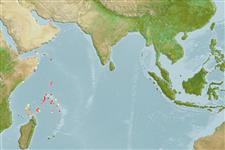Environment: milieu / climate zone / profondeur / distribution range
Écologie
marin benthopélagique; profondeur 810 - 1022 m (Ref. 26165). Deep-water; 16°N - 12°S, 44°E - 60°E (Ref. 6181)
Western Indian Ocean: in tropical areas. Western Central Pacific: Southeast Asia. References to a catch from Walvis Ridge in the southeastern Atlantic are based on a single specimen from the collection of Pakhorukov that requires confirmation.
Taille / Poids / Âge
Maturité: Lm ? range ? - ? cm
Max length : 100.0 cm SL mâle / non sexé; (Ref. 27121)
Épines dorsales (Total) : 41 - 43; Rayons mous dorsaux (Total) : 53 - 55; Épines anales: 2; Rayons mous anaux: 43 - 46; Vertèbres: 99 - 102. Pelvic fins represented by a single spine in juveniles inserted before the base of the pectoral fins, but entirely absent in adults. Body color is coppery black with iridescent tint. The inside of the mouth and gill cavities black.
Body shape (shape guide): eel-like; Cross section: compressed.
Inhabits deeper waters of continental shelf and slope (Ref. 27121).
Life cycle and mating behavior
Maturité | Reproduction | Frai | Œufs | Fécondité | Larves
Nakamura, I. and N.V. Parin, 1993. FAO Species Catalogue. Vol. 15. Snake mackerels and cutlassfishes of the world (families Gempylidae and Trichiuridae). An annotated and illustrated catalogue of the snake mackerels, snoeks, escolars, gemfishes, sackfishes, domine, oilfish, cutlassfishes,. scabbardfishes, hairtails, and frostfishes known to date. FAO Fish. Synop. 125(15):136 p. (Ref. 6181)
Statut dans la liste rouge de l'IUCN (Ref. 130435: Version 2025-1)
Menace pour l'homme
Harmless
Utilisations par l'homme
Pêcheries: bycatch
Outils
Articles particuliers
Télécharger en XML
Sources Internet
Estimates based on models
Preferred temperature (Réf.
123201): 1.8 - 3.2, mean 2.5 °C (based on 30 cells).
Phylogenetic diversity index (Réf.
82804): PD
50 = 0.5078 [Uniqueness, from 0.5 = low to 2.0 = high].
Bayesian length-weight: a=0.00046 (0.00020 - 0.00105), b=3.12 (2.92 - 3.32), in cm total length, based on LWR estimates for this (Sub)family-body shape (Ref.
93245).
Niveau trophique (Réf.
69278): 4.2 ±0.7 se; based on size and trophs of closest relatives
Résilience (Réf.
120179): Faible, temps minimum de doublement de population : 4,5 à 14 années (Assuming tmax>10).
Fishing Vulnerability (Ref.
59153): High to very high vulnerability (73 of 100).
🛈
